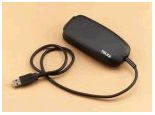|
|
|
Headset Microphones for Speech Recognition
I have found the Andrea headset microphone to be of high quality for speech recognition. It has comfortable foam earcushions, is durable, and it has a flexible Microphone Boom. The flexible boom can be adjusted (much like a gooseneck cord) for acuarate postioning of the microphone.
InSync Software Inc
This USB sound pod connects to USB Port, and no additional software is required as it works with drivers already present in Windows operating system software. Buddy USB2 FD for  speech recognition is an ideal replacement sound card for laptop (and desktop) computers. speech recognition is an ideal replacement sound card for laptop (and desktop) computers.
|
If you are using speech recognition on a laptop computer, or even experiencing problems with your desktop's soundcard  you should consider connecting the headset microphone to an USB Pod converter for audio input. The USB pod bypasses to sound card,and provides direct input into the computers sound system. you should consider connecting the headset microphone to an USB Pod converter for audio input. The USB pod bypasses to sound card,and provides direct input into the computers sound system.
|
USB Pod
www.microphones.com
|
There is an additional benefit of an USB pod vs. souncard for audio input. For the transferring of a user's speech file from one computer system to another. If using a sound card for audio input, the user will have to start "from scratch", retraining, and creating a new voice file because each soundcard's unique voice patterns.
Use of an USB pod allows for "saving" the user's unique vocabulary file-- eliminating soundcard dependence.
NOTE: A user's voice file is generally 52MB or greater in size. You will need to back up such a file on a mass media storage device as a "Zip Drive" or "ReWritable" Drive.
|
|

